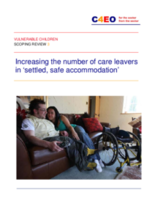This scoping study assesses the nature and extent of the evidence base in relation to increasing the number of care leavers in ‘settled, safe accommodation’. The Social Care Institute for Excellence (SCIE) carried out the study on behalf of the Centre for Excellence and Outcomes in Children and Young People’s Services (C4EO), between November 2008 and February 2009.
The scoping study’s prime purposes are to establish the key review questions and search parameters for later review work, assess the nature and strength of the evidence base and provide an initial overview of trends in the literature.
This study aims to identify the scale and scope of the evidence base in the literature for four key review questions:
1. What do we know about the accessibility, acceptability and effectiveness of policies, services and interventions initiated by central, regional and local government and independent sector, including housing services and housing support services, for looked after children and young people (LACYP)?
In answer to this question, the study found that evidence was more descriptive than evidence based. The literature reviewed two areas of effectiveness: North America based evaluations of Independent Living Programs (ILP) and UK leaving care services. Housing services were found to be buried within other services.
2. What are LACYP’s views on what constitutes safe and settled accommodation and how do they compare to those of policy-makers, housing and children’s services personnel and independent sector providers?
This answer mentioned small sample studies. A recurring theme in the literature tended to be inaccessible and unacceptable housing.
3. What do we know about the contribution made to being in safe, settled accommodation of LACYP by the attitudes, skills and abilities of foster, residential, kinship carers, supported housing staff and birth families, and interventions to support this contribution?
The scoping group found very little that related to interventions, etc.
4. What do we know about the 12.6 per cent of young people not in suitable accommodation at age 19 (as defined by National Indicator 147)?
The evidence found was mostly North America based.
The Key Points of the study noted several absences, including absences in discussion of possible conceptual and theoretical frameworks through which to understand young people’s experiences of leaving care and finding safe, settled accommodation and absences in the variety of types of study available.
The study noted:
Both the UK and North American literature highlight the role of housing for young people leaving care, with the US pointing to innovative collaborations between the independent sector, children’s welfare services and house builders. Both the UK and US literature also consider the importance of independent living schemes.

